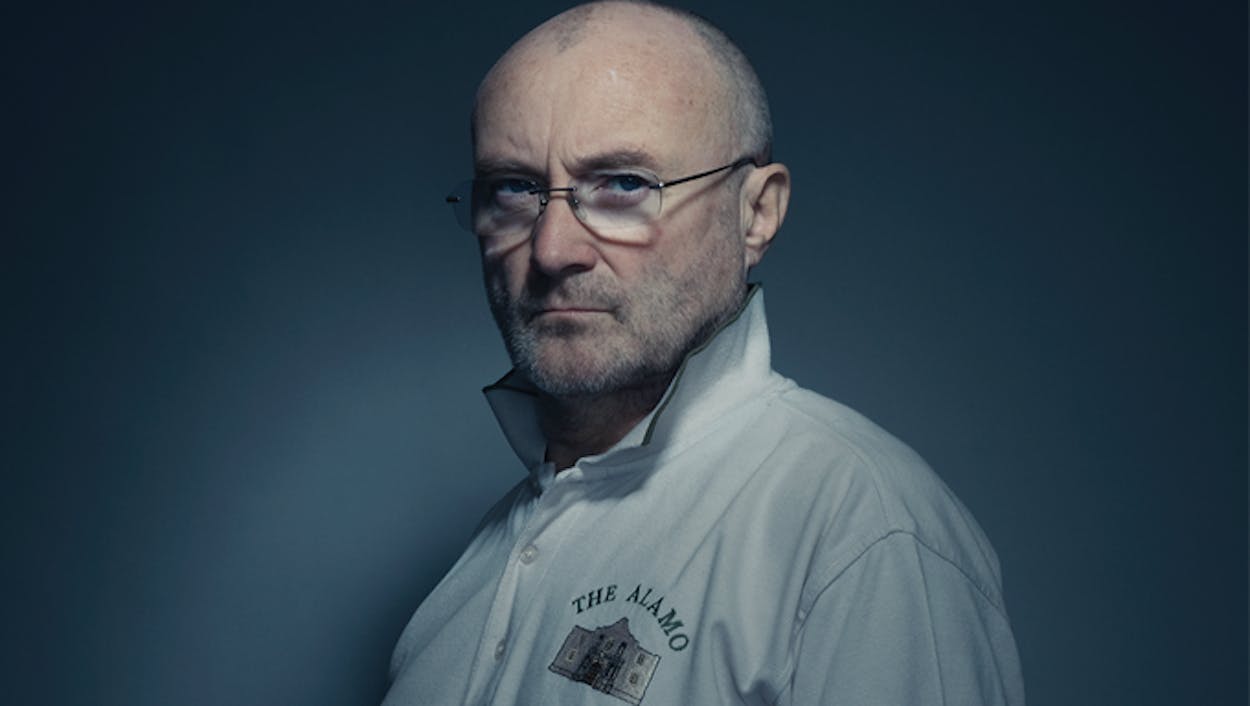In the five years since Phil Collins first made known his lifelong fascination with the Alamo, news coverage of his interest in Texas history has ranged from the man-bites-dog variety to downright mean. For Texans, the fact that one of the world’s richest musicians—Collins has sold more than 250 million records—might spend a small fraction of his royalty checks collecting treasured artifacts from the Texas Revolution is not so hard to fathom. Or at least that was the intended takeaway from Texas Monthly’s January 2012 story on Collins, “Come and Take a Look at Me Now.” The rock-and-roll press and British tabloids, on the other hand, have taken a different view. In a 2011 story, Rolling Stone depicted him as a rejected relic of the eighties who sits in his basement in Lake Geneva, Switzerland, staring at Jim Bowie’s knife and Davy Crockett’s rifle and thinking about killing himself. London’s Daily Mail called him “one drumstick shy of a pair.”
Well, prepare yourself, naysayers, because now Phil Collins has done something truly weird. This afternoon, the Texas General Land Office announced that the pop star has agreed to donate his collection, which is thought to be worth tens of millions of dollars, to the state. For free. All of it. That includes hundreds of documents, ranging from a letter Stephen F. Austin wrote from a Mexican prison in January 1834 and Sam Houston’s original 1835 land grant for property in East Texas to the signed receipt for thirty beeves that William Travis brought into the Alamo on the day the siege began, plus artifacts like uniforms and Brown Bess muskets that belonged to Mexican soldiers, a sword belt believed to have been worn by Travis when he died atop the northern wall, and a shot pouch that Crockett is thought to have given a Mexican soldier just before he was executed.
The deal was initiated by Kaye Tucker, a GLO project manager who has been the agency’s unofficial Alamo liaison since it assumed custody of the site from the Daughters of the Republic of Texas in 2011. “We’ve always had a pipe dream to get a collection like this,” she told me over the phone this morning while stuck in I-35 traffic on the drive from Austin to San Antonio. “My understanding was that he had been talking to some area museums about an exhibit, so I had dinner with him and asked if he’d consider giving at least part of it to the Alamo. To my amazement, he just said, ‘Yes.’ ” The logistics of the gift, like how it will be shipped, insured, and stored upon arrival, have yet to be hammered out, she said. “But Phil said he’s even been looking into that.”
The deal is part of a larger effort by the GLO to improve Texas’s most sacred historical site. “We’ve got big plans for the Alamo,” land commissioner Jerry Patterson told me yesterday afternoon. “We’ve created the Alamo Endowment, a nonprofit, to raise attention and money. We want to increase the site’s footprint, maybe not all the way to its original size, but as close as we can to the whole thing. We want to tell the whole story, of the Tejanos and Mexicanos who died there too. And we want a permanent Phil Collins Collection in an Alamo Visitors’ Center that we intend to build.”
For Patterson, who will leave office when his third term ends this January, fixing up the Alamo is a way to ensure his own legacy, and acquiring Collins’s pieces could be the kind of coup that drives future fundraising. But for every tourist who’s ever rolled through downtown San Antonio only to arrive at the Alamo and feel deflated, the gift could provide a means for contextualizing and envisioning the Texas creation story in a way that has never existed before. Artists have tried to present the Alamo in paintings, movies, and books, but they’ve invariably had to turn to legend to complete their looks. Collins’s collection is the actual stuff that gave birth to the legend.
Collins and Patterson will make the gift official at a press conference at the Alamo on Thursday morning. In the meantime, the pop star has yet to respond to emails for comment. “He’s dramatically unassuming, actually even less assuming than your average guy,” said Patterson, who was impressed by Collins in their one meeting, a dinner at San Antonio’s Emily Morgan Hotel. “But he knows more about the Alamo than I do. His collection is substantial, it’s valuable, and it needs to be labeled in honor of the guy who put it together. That’s Phil Collins.”








